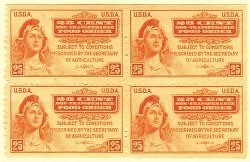
PREV ARTICLE
NEXT ARTICLE
FULL ISSUE
PREV FULL ISSUE
AN INTAGLIO FOOD STAMP TEST PLATE
An article by Neil Shafer from Bank Note Reporter was published on NumisMaster.com discussing an unusual intaglio test plate, the only printing plate to lawfully come out of the Bureau of Engraving and Printing in modern times. Craig Covert of Ft. Lauderdale, FL provided much of the information for the article. Here are some excerpts.
-Editor
"When the BEP abandoned the idea of using a Web press...the test press sat in the BEP intaglio research room...and this plate was bolted to the press…" "How did this test press become privately owned? "At some point, BEP officials figured that storing the press was not beneficial to the Bureau. The web test press weighed more than 18,000 pounds. So, it was offered for sale. The only likely buyers were firms or individuals involved in the security printing business. A particular family owning a manufacturing firm with interests" in security printing "wanted the press because it contained parts that could be used for their" manufacturing purposes. "Why was the plate included with the press? "Why not, the plate could not feasibly be used for any other purpose. The plate itself weighs 112.6 pounds…the buyer got a bill of sale for both the press and the plate." "Can anyone purchase currency plates or test plates from the BEP? "Absolutely not! Intaglio plates are the holy grail of security and the BEP will never sell anything like this again. It is truly one of a kind and is the only plate to lawfully come out of the BEP in modern times." Further correspondence with Craig elicited more details. The first question had to do with the altered $5 Food Coupon with the NON-NEGOTIABLE title as I was really wondering how that fit in the scheme of things. His answer was that it was a proof from a die created to run initially on the BEP Intaglio Test Plate/Hamilton Research Press, not the later Web Currency Press. It was decided not to use that design as it resembled currency or Food Coupons too closely. My own observations on this piece amplify what Craig wrote. Some words of the nonsense legend are those from an actual Food Coupon but with letters scrambled. Other words do not appear to conform entirely. There is no imprint on this piece, as stated previously, but there is such an indication on the TEST PLATE note indicating coordination from Security-Columbian Banknote Co. on the production of this item. Hamilton Tool Co. required an engraved piece for factory-testing the Research Press at its Hamilton, Ohio facility. The TEST PLATE image was the one approved by the BEP. I asked how many images were around the test plate. The answer was 18. Craig sent more facts on some of the technical aspects of the development of this 18-subject plate. The images are all the same but with differing depths in groups of three images. These differences help to test for an ideal engraving depth to be used for an intaglio web print and for later development of the Web Currency Press plates. The depth distinctions also helped with the testing for plate wiping which was done both by paper and water, but not at the same time. Engraving depths went from the lightest at five to 10 microns to the deepest at 50-60 microns. Each group of three images had its own number. Group 1 had the lightest engraving and Group 6 the deepest. According to Craig, many of the Test Plate notes now held by collectors have severe streaking, almost certainly from testing the water-wipe system. (The BEP uses a water-wipe process for all its intaglio plates.) Part of the development process was to gain knowledge of the water-wipe process for eventual use on the Web Currency Press. Most worldwide intaglio presses uses a paper-wipe system. Additionally, pieces with "offsetting" have details of notes showing that came from the end of the press going through what Craig called the sheeter assembly. The wheels of this unit were caked with intaglio ink because at the time there was no quick-drying technique available. The plate also had a taper of about 80-90 to 1 from the outside to the inside. This design was used so the plate would fit or securely fasten to the press and heat evenly.
To read the complete article, see:
Intaglio Test Plate Surfaces at FUN
(www.numismaster.com/ta/numis/Article.jsp?ad=article&ArticleId=17862)
The Numismatic Bibliomania Society is a non-profit organization promoting numismatic literature. See our web site at coinbooks.org. To submit items for publication in The E-Sylum, write to the Editor at this address: whomren@gmail.com To subscribe go to: https://my.binhost.com/lists/listinfo/esylum All Rights Reserved. NBS Home Page Contact the NBS webmaster 
|
